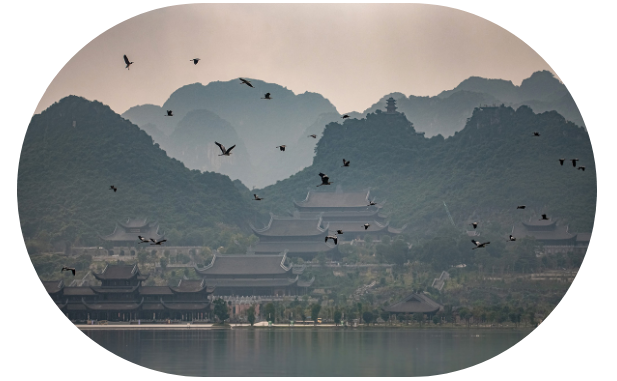
The islands around Tam Chuc Pagoda with peaceful scenery are ideal bird photography for nature-loving photographers.

Tam Chuc Pagoda, the largest Buddhist temple in Vietnam, is located on the foundation of an ancient temple of the same name, over 1,000 years old. Tam Chuc Pagoda is located in Ba Sao town, Kim Bang district, Ha Nam province, about 50 km south of Hanoi center.
Tam Chuc spiritual tourism area covers an area of over 5,000 hectares, including spiritual tourism areas, lake-bed areas and resorts. In the photo is a spiritual tourist area over 40 meters above the lake surface, with items from the bottom up including the Tam Quan Gate, the Pillar Kinh Garden, the Quan Am Palace, the Dharma Master Palace and the Tam The Palace. Photo: Ha Vu Linh

By the end of 2020, “Squad Le foul” – the names of four members who are passionate about bird photography – including Mr. Vo Rin, Nguyen Hong Huy, Ha Vu Linh and Ms. Nguyen Thuy Linh had a survey and photo shoot here. .
Gray herons fly over the lake, which is known as “Ha Long on land” in Ha Nam because of the surrounding limestone mountains. Photo: Ha Vu Linh

Ha Vu Linh, a photographer born in 1993, said he was very excited to experience the bird photography trip with the team. Linh was impressed with the gray heron, the bird with the largest number, up to thousands residing in Tam Chuc. Photo: Ha Vu Linh

Gray herons and large storks in the parking lot on the artificial island, the far side are barges that are building the artificial island. The islands provide habitat for birds to live and breed. Tam Chuc tourist area management board only allows people and tourists to go by boat to watch birds, prohibit bird hunting in the whole tourist complex, and always have staff to watch them. Photo: Ha Vu Linh.

During bird hunting in Tam Chuc, the group had to wade in shallow water, put on a dark camouflage coat, covered with nets and placed machines and equipment on buoys to watch for birds. This camouflage is intended to not scare the birds.
In addition to love, passion for nature and photography, the photographer must also equip equipment such as binoculars, 400 mm – 600 m telephoto lens. Photo: Ha Vu Linh

The gray heron’s take-off dance.
Vo Rin likes bird photography because it brings a lot of fun and fun to life. He has been photographing for 15 years but has been shooting birds for 2.5 years and has taken about 395 species in Vietnam.
Compared to other bird sanctuaries in Vietnam, Tam Chuc Pagoda’s habitat is diverse, so the species of birds are abundant. Water and forest birds are available, commonly gray herons, fire herons, storks, cauldrons living in lagoons, lakes, and wild birds such as jays, pepper bananas, and hawks. In addition, there is also a marble stump, endemic species in Vietnam and a conservation of ivory-billed starling.
“Through a survey trip combining tourism and photography, the photography team recorded nearly 30 species of birds in the area. Fortunately, Tam Chuc is a place where there are favorable factors and conditions for many species of birds to develop, ”said Mr. Vo Rin. Photo: Vo Rin

Photographing ginseng is the biggest difficulty for the group, especially the moment when birds “fly” on the water. Peanut worm, about 41 cm long, belongs to the water fowl family, living in swamps and freshwater lakes, is now a rare species in the wild in Vietnam. Photo: Vo Rin

Long tailed stick on the top of the reed grass. This species is about 25 cm long, has a long tail, gray head, brown back, wings and a black tail. They live in popularity where they can be over 2,000 m high.
The photo was taken by Nguyen Thuy Linh (30 years old) while traveling with the group on a tram in Tam Chuc. She shared that this bird was very shy, so she had to be flexible when it came to flying, so she had to be flexible, use the equipment proficiently and shoot quickly. Photo: Nguyen Thuy Linh.

Photographing stinking birds carries many group memories during the trip, so the group name is also named after this bird. The group had to take a boat on the lake for about 2 hours in the early morning to have a beautiful moment about this bird, when the lilies were still blooming beautifully as the foreground. Sitting on the boat, everyone worried about high-value capture equipment.
Le foul is a diving bird, 23-29 cm long, the smallest of the four species of leeches in Vietnam. The bird has a white ring around the eyes, a small pointed beak, dark upper part with a gray-brown neck in the non-breeding season, a white lower body visible only in flight. Photo: Nguyen Thuy Linh.

In the photo is a brown-headed lizard species, about 12 cm long, usually living in grassy areas and bushes, distributed from the Northeast to the South.
During the trip, the group was lucky when the weather was nice, sunny. The group usually gets up at 5:30 am to prepare for a day of shooting. Each person carries a apparatus and rides an electric car, boat around every corner, discovering the aim is to shoot. Photo: Nguyen Hong Huy.

Marble hornet, endemic species of Vietnam recorded in Tam Chuc. This species of bird has an average size of about 20 cm. The bird is predominantly gray-brown with many white, scaly feathers on the upper body (from the top of the head to the upper back), many large, dark stripes on the neck, and the lower body is light brown.
“Through the series of bird photos in Tam Chuc, the whole group wants to convey the message that everyone join hands in conservation of nature and birds, especially rare species”, Hong Huy said. Photo: Nguyen Hong Huy.
Follow vnexpress
